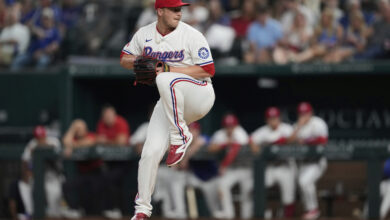
Threading Needle Between Glove-First Approach, Bat-First Prospects Won’t Be Easy
In their never-ending quest for value, the Cubs built a roster around defense up the middle that could turn grounders from their low-velocity pitching staff into outs. The big problem with that concept, and with the broader avoidance of superstars in general, is that it lowers the ceiling while also raising the floor. The result is a cramped living area with far too much unused space in the attic.
It felt at the time that they’d perhaps overcorrected from the previous era in which their production was too volatile. What’s ironic about the whole thing is that the 2016 team may have been the best defensive unit of all time. After burning hot for a few seasons and failing to achieve the sustained success that is still being promised, Theo Epstein handed the reins to Jed Hoyer and the organization rebuilt retooled reconfigured.
Hoyer doesn’t like to use any of those terms, which is understandable because the Cubs are like a car in rush hour that keeps changing lanes and always seems to pick the one that stops moving. The organizational philosophy of drafting “safe” pitchers failed catastrophically, setting the Cubs back several years and effectively forcing them to jettison most of their star players.
We can argue over the necessity and wisdom of those moves in a number of different ways, but the fact of the matter is that their pitching development flat-out sucked. Then they went the other direction and couldn’t produce enough position players who could come up and rake in Chicago. Christopher Morel looked like he might be that guy until his inability to play a position pushed Hoyer to swing a trade for Isaac Paredes, who the Cubs had dealt years earlier for, you guessed it, pitching help.
So now we look at 2025 and beyond as several young hitters are poised to make their way to the bigs after dominating at every previous level. Two of them in particular, Moises Ballesteros and Matt Shaw, could tell the story of whether and how the Cubs return to legitimacy in the National League. Ballesteros was recently named the team’s Minor League Player of the Year and is currently tearing up the Arizona Fall League, leading many — present company included — to believe he’s got nothing left to prove at Triple-A.
Same goes for Shaw on the prove-it front, as he transitioned smoothly from the University of Maryland to the minors to become the Cubs’ top-rated prospect. Blessed with 60-grade power and a patient approach, Shaw reminds me a little of steroid-era Bret Boone. With full understanding that he probably won’t generate a 140 wRC+ right out of the gate, he has clear potential as a difference-making hitter.
With both players, however, there’s a very real question about where they’re going to play. Ballesteros is primarily a catcher by trade, though he’s not ready to handle that position on a regular basis in the bigs and his fire-hydrant frame may not be fit for first base either. Shaw has been moved around the infield with the hope that he could handle the hot corner, but most evaluators keep coming back around to him being a much better fit at second base.
While designated hitter would be an option for either, the number of available at-bats will be determined by Cody Bellinger‘s decision and how that impacts Seiya Suzuki. I still say Bellinger is likely to opt out, at which point there’s room for one prospect. But wait, what about Owen Caissie in all this? He’s may have the most pop of anyone in the entire organization and likewise raked in Iowa, yet he’s also positionally limited to the corner outfield spots.
We don’t even need to go deeper than that on the prospect depth chart because there are already too few spots for just two of these guys. Sorry for retracing my footsteps on this topic, it’s just that I still can’t see a clear path for Hoyer to follow when it comes to who to keep and who to trade. Whether it’s immovable contracts (Dansby Swanson), no-trade clauses (Suzuki and Ian Happ), or the possible catch-22 of trading a would-be superstar while keeping a future dud, I’m concerned that the Cubs could end up doing nothing.
Which is to say they won’t take a big swing for a controllable star and will keep their prospects in the minors for longer than necessary. I guess that’s why Hoyer is making the big bucks and I’m sitting here at a keyboard freaking out about the future when we still don’t even have all the puzzle pieces in place. We’ve heard a lot about threading the needled over the last few years, and I think this winter is when Hoyer will finally have to start sewing.

